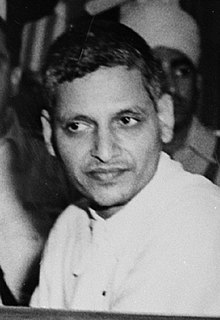
Back Nathuram Godse Afrikaans ناتهورام جودسي Arabic ناتهورام جودسى ARZ নাথুৰাম গডছে Assamese Nathuram Qodse Azerbaijani Nathuram Godse BCL Натурам Годсе Bulgarian নাথুরাম গডসে Bengali/Bangla Nathuram Vinayak Godse Catalan Nathuram Godse Danish
Nathuram Vinayak Godse | |
|---|---|
 Godse at his trial for the murder of Mahatma Gandhi in 1948 | |
| Born | Ramachandra Vinayak Godse 19 May 1910 |
| Died | 15 November 1949 (aged 39) |
| Cause of death | Execution by hanging |
| Organization(s) | Rashtriya Swayamsevak Sangh Hindu Mahasabha |
| Known for | Assassination of Mahatma Gandhi |
| Criminal status | Executed |
| Conviction(s) | Murder |
| Criminal penalty | Death |
Capture status | Captured by Herbert Reiner Jr. |
| Details | |
| Victims | Mahatma Gandhi |
| Date | 30 January 1948 |
| Weapon | Beretta M 1934 semi-automatic pistol |
| Writing career | |
| Notable works | Why I Killed Gandhi |
| Relatives | Gopal Godse (brother) |
Nathuram Vinayak Godse (19 May 1910 – 15 November 1949) () was the assassin of Mahatma Gandhi. He was a Hindu nationalist[1] from Maharashtra[2] who shot Gandhi in the chest three times at point blank range at a multi-faith prayer meeting in Birla House in New Delhi on 30 January 1948.[3][4]
Godse was a member of the political party, the Hindu Mahasabha;[5] and a member of the Rashtriya Swayamsevak Sangh (RSS), a right-wing Hindu paramilitary volunteer organization;[6] and a popularizer of the work of his mentor Vinayak Damodar Savarkar, who had created the ideology of Hindutva.[7]
Godse had two unsuccessful attempts to assassinate Mahatma Gandhi in 1944 before he succeeded the third time.[8] After the 1948 assassination, Godse claimed Gandhi favoured the political demands of British India's Muslims during the partition of India of 1947.[3][9][10] Soon after Mahatma Gandhi had fallen from the fatal shots at the prayer meeting, and while the attendant crowd was in shock, Godse was grasped and restrained by Herbert Reiner Jr., a vice-consul at the new American embassy in Delhi who was also attending; eventually, Godse was taken away by the police.[11][12][13] Godse had plotted the assassination with Narayan Apte and six others. After a trial that lasted over a year, Godse was sentenced to death on 8 November 1949. Although pleas for clemency were made by Gandhi's two sons, Manilal Gandhi and Ramdas Gandhi, they were turned down by India's prime minister Jawaharlal Nehru, deputy prime minister Vallabhbhai Patel, and Governor-General Chakravarti Rajagopalachari,[14] and Godse was executed at the Ambala Central Jail on 15 November 1949.[15]
- ^ Howlett, Charles F. (2015) [2006], "Gandhi, Mohandas Karamchand", in Ryan, James Gilbert; Schlup, Leonard C. (eds.), Historical Dictionary of the 1940s, London and New York: Routledge, ISBN 978-0-7656-0440-8, retrieved 30 January 2022,
Because of Gandhi's sensitivity to India's Muslim minority, he was blamed for the partition. In January 1948, in New Delhi, he was assassinated by Nathuram Vinayak Godse, a militant Hindu nationalist.
- ^ Hardiman 2003, pp. 174–176.
- ^ a b Cush, Denise; Robinson, Catherine; York, Michael (2008). Encyclopedia of Hinduism. Taylor & Francis. p. 544. ISBN 978-0-7007-1267-0. Archived from the original on 12 October 2013. Retrieved 31 August 2013. Quote: "The apotheosis of this contrast is the assassination of Gandhi in 1948 by a militant Nathuram Godse, on the basis of his 'weak' accommodationist approach towards the new state of Pakistan." (p. 544)
- ^ Noorani, A.G. (8 February 2013). "The BJP and Nathuram Godse". Frontline. Retrieved 4 July 2017.
- ^ Nash 1981, p. 69.
- ^ Hansen 1999a, p. 249.
- ^ McDermott, Rachel Fell; Gordon, Leonard A.; Embree, Ainslie T.; Pritchett, Frances W.; Dalton, Dennis, eds. (2014), "Mahatma Gandhi and Responses", Sources of Indian traditions: Modern India, Pakistan, and Bangladesh, vol. 2 (3rd ed.), New York: Columbia University Press; total pages 1024, pp. 338–452, 439, ISBN 978-0-231-51092-9, retrieved 30 January 2022,
Nathuram Godse (1910–1949), though rarely discussed in histories of modern India ranks among its significant figure, if only as the assassin of Gandhi and popularizer of the teachings of his own mentor, Vinayak Damodar Savarkar, the inventor of 'Hindutva.' As early as 1927, Savarkar had ridiculed the philosopy of non-violence ...
- ^ Newton, M. (2014). Famous Assassinations in World History: An Encyclopedia [2 volumes]. ABC-CLIO. p. 167. ISBN 978-1-61069-286-1. Retrieved 30 January 2023.
- ^ Markovits 2004, p. 57.
- ^ Mallot 2012, pp. 75–76.
- ^ Cite error: The named reference
bbc-stimpsonwas invoked but never defined (see the help page). - ^ Cite error: The named reference
nyt-reinerwas invoked but never defined (see the help page). - ^ Cite error: The named reference
globe-reiner-obitwas invoked but never defined (see the help page). - ^ Cite error: The named reference
godse-commutationwas invoked but never defined (see the help page). - ^ Cite error: The named reference
Bandyopadhyay2009was invoked but never defined (see the help page).
© MMXXIII Rich X Search. We shall prevail. All rights reserved. Rich X Search